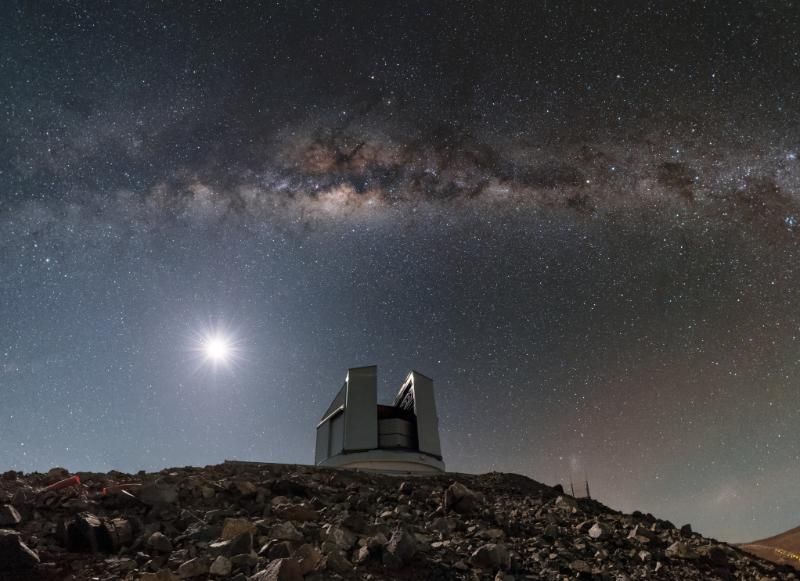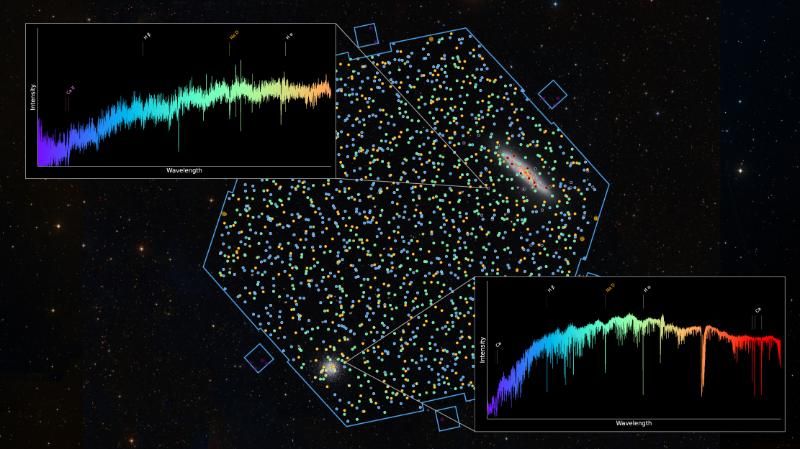Trinity team poses deep-space questions of mysterious dark energy
Posted on: 21 October 2025
Astrophysicists are leading a project (TiDES) that will improve our understanding of the mysterious “dark energy” that comprises roughly two-thirds of the Universe and is responsible for its accelerating expansion. Their project kicks off as the revolutionary 4MOST facility captures its first light.
To further understanding of this, they will utilise the revolutionary 4-metre Multi-Object Spectroscopic Telescope (4MOST) facility, which is installed on the VISTA telescope at the European Southern Observatory’s (ESO) Paranal Observatory in Chile.
 The Visible and Infrared Survey Telescope for Astronomy (VISTA), situated at the Paranal Observatory. Perched atop a mountain adjacent to Cerro Paranal, the home of the flagship Very Large Telescope (VLT), VISTA is the largest telescope in the world designed to survey the sky in near-infrared light (just beyond that visible to humans). The spectacular sights of the cosmos —including the notable streak of our home galaxy, the Milky Way, stretching across the top of the frame here —are more than enough to keep VISTA and its telescopic siblings busy. Credit: ESO/B. Tafreshi (twanight.org).
The Visible and Infrared Survey Telescope for Astronomy (VISTA), situated at the Paranal Observatory. Perched atop a mountain adjacent to Cerro Paranal, the home of the flagship Very Large Telescope (VLT), VISTA is the largest telescope in the world designed to survey the sky in near-infrared light (just beyond that visible to humans). The spectacular sights of the cosmos —including the notable streak of our home galaxy, the Milky Way, stretching across the top of the frame here —are more than enough to keep VISTA and its telescopic siblings busy. Credit: ESO/B. Tafreshi (twanight.org).
This past weekend 4MOST obtained its “first light” – a crucial milestone in the life of any telescope, marking the moment it is ready to begin its scientific journey.
What makes 4MOST so special is that it does not simply take images of the sky; instead, it records spectra, capturing the light of each object in every individual colour.
With this capability, it can unravel the light of 2,400 celestial objects simultaneously into 18,000 colour components, allowing astronomers to study their detailed chemical composition and properties. It is the largest multi-object spectroscopic survey facility in the Southern Hemisphere. Development started in 2010 and the facility has been designed to operate for at least the next 15 years.
The TiDES project seeking to lift the lid on the deep-space secrets of dark energy
The Trinity team, led by Prof. Kate Maguire from the School of Physics, is actively involved in one of the main surveys to be carried out with 4MOST – the Time Domain Extragalactic Survey (TiDES), which will also capitalise on the new multi-billion dollar telescope, the US National Science Foundation/Department of Energy-led Vera C. Rubin Observatory (Rubin).
Every time 4MOST observes, TiDES will use a handful of its fibres to observe recently discovered “transient” objects discovered in Rubin’s Legacy Survey of Space and Time (LSST).
The 4MOST observations of tens of thousands of exploding stars (supernovae) and other exotic and dramatic phenomena, such as the shredding of stars by supermassive black holes, will be the largest such programme dedicated to Rubin.
Prof. Maguire said: “TiDES will transform our understanding of how stars evolve and die, and contribute to the most precise measurements of the effects of dark energy on the cosmic expansion rate and the fundamental make up of our Universe.”
“It’s a big challenge to handle the very large data stream from Rubin and 4MOST, and we have had to develop novel techniques to make the most of some of the incredible technologies at hand. Ultimately we are pursuing first-of-its-kind research that will add to our understanding of some of the most important and fundamental processes at play in the Universe.”
 The First Light field of view with example spectra. Credit: AIP/R. de Jong, Centre de Recherche Astrophysique de Lyon/J. - K. Krogager. Background: Harshwardhan Pathak/Telescope Live.
The First Light field of view with example spectra. Credit: AIP/R. de Jong, Centre de Recherche Astrophysique de Lyon/J. - K. Krogager. Background: Harshwardhan Pathak/Telescope Live.
Dr Tomás Müller-Bravo, another researcher in Trinity's School of Physics, is active on the TiDES software design for finding and tracking these new explosions. He added: “I’m really excited that 4MOST will soon start obtaining this revolutionary dataset, which will help us better understand how stars explode and address the origin of the mysterious quantity, dark energy.”

 The Visible and Infrared Survey Telescope for Astronomy (VISTA), situated at the Paranal Observatory. Perched atop a mountain adjacent to Cerro Paranal, the home of the flagship Very Large Telescope (VLT), VISTA is the largest telescope in the world designed to survey the sky in near-infrared light (just beyond that visible to humans). The spectacular sights of the cosmos —including the notable streak of our home galaxy, the Milky Way, stretching across the top of the frame here —are more than enough to keep VISTA and its telescopic siblings busy. Credit: ESO/B. Tafreshi (twanight.org).
The Visible and Infrared Survey Telescope for Astronomy (VISTA), situated at the Paranal Observatory. Perched atop a mountain adjacent to Cerro Paranal, the home of the flagship Very Large Telescope (VLT), VISTA is the largest telescope in the world designed to survey the sky in near-infrared light (just beyond that visible to humans). The spectacular sights of the cosmos —including the notable streak of our home galaxy, the Milky Way, stretching across the top of the frame here —are more than enough to keep VISTA and its telescopic siblings busy. Credit: ESO/B. Tafreshi (twanight.org). The First Light field of view with example spectra. Credit: AIP/R. de Jong, Centre de Recherche Astrophysique de Lyon/J. - K. Krogager. Background: Harshwardhan Pathak/Telescope Live.
The First Light field of view with example spectra. Credit: AIP/R. de Jong, Centre de Recherche Astrophysique de Lyon/J. - K. Krogager. Background: Harshwardhan Pathak/Telescope Live.